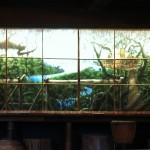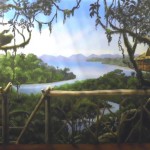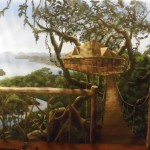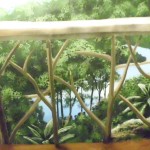On various jobs over the years, I’ve had to improvise when there wasn’t sufficient access to the mural surface. One that stands out in my mind was a midwestern zoo job featuring an artificial mangrove swamp.
The theme company I was subcontracting for had to install the mangrove plants before I could get the background painted. This meant painting the scene through the tangle of mangrove branches, where there was often insufficient space to get in a hand with a brush, let alone a spray gun. To aggravate matters, the back side of the artificial branches often contained rusty, razor-like barbs from steel mesh poking through the epoxy putty.
I solved the problem by cutting the bottoms out of tall plastic cups and wearing the cups like armor secured to my forearms with duct tape. The end result was acceptable but nothing like I envisioned if I had been allowed adequate access to the wall.



